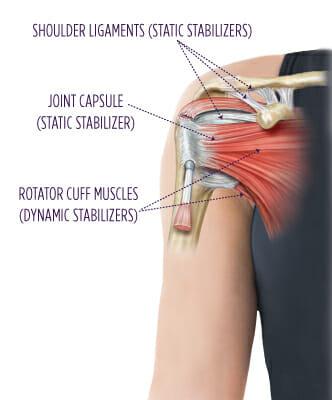

What keeps my shoulder stable?
The shoulder relies on two types of stabilizers:
- Dynamic stabilizers – the rotator cuff muscles, which stabilize the shoulder while it is moving
- Static stabilizers – the ligaments and joint capsule, which prevent the joint from stretching beyond its normal range of motion
However, there is a limit to the amount of force your shoulder ligaments can withstand. If that limit is surpassed, the ligament can be either stretched or torn. Damaging the shoulder’s stabilizers in this way can result in shoulder instability.
Learn more about shoulder anatomy
What are the symptoms of shoulder instability?
Common symptoms of chronic shoulder instability include:
- A sense that the shoulder is “coming out of socket” in certain positions
- Generalized weakness of the shoulder
- Pain when performing specific activities
- Painful clicking and popping sensations
- Occasional numbness and tingling in the affected arm or hand
How is shoulder instability diagnosed?
The diagnostic process starts by talking with you about your symptoms and conducting a detailed physical examination. Diagnostic imaging, including X-rays and MRI scans, can be useful for a diagnosis as well.
How is shoulder instability treated?
Treatment depends largely on the instability of your shoulder and how it affects day-to-day activities. Physical therapy may be sufficient to help you gain strength in the group of muscles and tendons that acts to stabilize the shoulder. In more severe cases, surgical repair may provide the most effective outcome.
Learn more about shoulder arthroscopy
